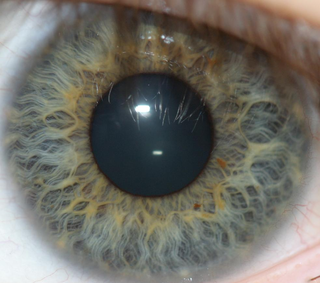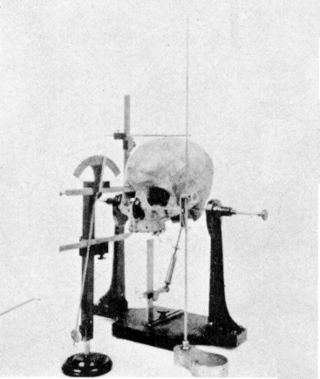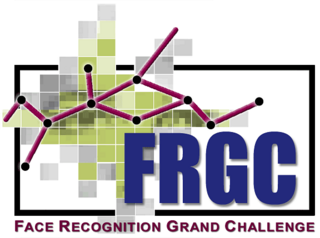Related Research Articles

Total Information Awareness (TIA) was a mass detection program by the United States Information Awareness Office. It operated under this title from February to May 2003 before being renamed Terrorism Information Awareness.
Affective computing is the study and development of systems and devices that can recognize, interpret, process, and simulate human affects. It is an interdisciplinary field spanning computer science, psychology, and cognitive science. While some core ideas in the field may be traced as far back as to early philosophical inquiries into emotion, the more modern branch of computer science originated with Rosalind Picard's 1995 paper on affective computing and her book Affective Computing published by MIT Press. One of the motivations for the research is the ability to give machines emotional intelligence, including to simulate empathy. The machine should interpret the emotional state of humans and adapt its behavior to them, giving an appropriate response to those emotions.

Iris recognition is an automated method of biometric identification that uses mathematical pattern-recognition techniques on video images of one or both of the irises of an individual's eyes, whose complex patterns are unique, stable, and can be seen from some distance. The discriminating powers of all biometric technologies depend on the amount of entropy they are able to encode and use in matching. Iris recognition is exceptional in this regard, enabling the avoidance of "collisions" even in cross-comparisons across massive populations. Its major limitation is that image acquisition from distances greater than a meter or two, or without cooperation, can be very difficult. However, the technology is in development and iris recognition can be accomplished from even up to 10 meters away or in a live camera feed.

A facial recognition system is a technology potentially capable of matching a human face from a digital image or a video frame against a database of faces. Such a system is typically employed to authenticate users through ID verification services, and works by pinpointing and measuring facial features from a given image.

Face detection is a computer technology being used in a variety of applications that identifies human faces in digital images. Face detection also refers to the psychological process by which humans locate and attend to faces in a visual scene.
The Facial Recognition Technology (FERET) database is a dataset used for facial recognition system evaluation as part of the Face Recognition Technology (FERET) program. It was first established in 1993 under a collaborative effort between Harry Wechsler at George Mason University and Jonathon Phillips at the Army Research Laboratory in Adelphi, Maryland. The FERET database serves as a standard database of facial images for researchers to use to develop various algorithms and report results. The use of a common database also allowed one to compare the effectiveness of different approaches in methodology and gauge their strengths and weaknesses.

A standard test image is a digital image file used across different institutions to test image processing and image compression algorithms. By using the same standard test images, different labs are able to compare results, both visually and quantitatively.

Cephalometry is the study and measurement of the head, usually the human head, especially by medical imaging such as radiography. Craniometry, the measurement of the cranium (skull), is a large subset of cephalometry. Cephalometry also has a history in phrenology, which is the study of personality and character as well as physiognomy, which is the study of facial features. Cephalometry as applied in a comparative anatomy context informs biological anthropology. In clinical contexts such as dentistry and oral and maxillofacial surgery, cephalometric analysis helps in treatment and research; cephalometric landmarks guide surgeons in planning and operating.
VeriFace is an online service for remote identity verification of customers developed by Slovak company Rokan Biometrics. It aims to provide biometric identity verification and customer onboarding via facial recognition software.

Multiple Biometric Grand Challenge (MBGC) is a biometric project. Its primary goal is to improve performance of face and iris recognition technology on both still and video imagery with a series of challenge problems and evaluation.

The Face Recognition Grand Challenge (FRGC) was conducted from May 2004 until March 2006 to promote and advance face recognition technology. It succeeded the Face Recognition Vendor Test.

The Face Recognition Vendor Test (FRVT) was a series of large scale independent evaluations for face recognition systems realized by the National Institute of Standards and Technology in 2000, 2002, 2006, 2010, 2013 and 2017. Previous evaluations in the series were the Face Recognition Technology (FERET) evaluations in 1994, 1995 and 1996. The project is now in an Ongoing status with periodic reports, and continues to grow in scope. It now includes tests for Face-in-Video-Evaluation (FIVE), facial morphing detection, and testing for demographic effects.
The Learning Applied to Ground Vehicles (LAGR) program, which ran from 2004 until 2008, had the goal of accelerating progress in autonomous, perception-based, off-road navigation in robotic unmanned ground vehicles (UGVs). LAGR was funded by DARPA, a research agency of the United States Department of Defense.
Identity-based security is a type of security that focuses on access to digital information or services based on the authenticated identity of an entity. It ensures that the users and services of these digital resources are entitled to what they receive. The most common form of identity-based security involves the login of an account with a username and password. However, recent technology has evolved into fingerprinting or facial recognition.
DeepFace is a deep learning facial recognition system created by a research group at Facebook. It identifies human faces in digital images. The program employs a nine-layer neural network with over 120 million connection weights and was trained on four million images uploaded by Facebook users. The Facebook Research team has stated that the DeepFace method reaches an accuracy of 97.35% ± 0.25% on Labeled Faces in the Wild (LFW) data set where human beings have 97.53%. This means that DeepFace is sometimes more successful than human beings. As a result of growing societal concerns Meta announced that it plans to shut down Facebook facial recognition system, deleting the face scan data of more than one billion users. This change will represent one of the largest shifts in facial recognition usage in the technology's history. Facebook planned to delete by December 2021 more than one billion facial recognition templates, which are digital scans of facial features. However, it did not plan to eliminate DeepFace which is the software that powers the facial recognition system. The company has also not ruled out incorporating facial recognition technology into future products, according to Meta spokesperson.
Emotion recognition is the process of identifying human emotion. People vary widely in their accuracy at recognizing the emotions of others. Use of technology to help people with emotion recognition is a relatively nascent research area. Generally, the technology works best if it uses multiple modalities in context. To date, the most work has been conducted on automating the recognition of facial expressions from video, spoken expressions from audio, written expressions from text, and physiology as measured by wearables.
FindFace is a face recognition technology developed by the Russian company NtechLab that specializes in neural network tools. The company provides a line of services for the state and various business sectors based on FindFace algorithm. Previously, the technology was used as a web service that helped to find people on the VK social network using their photos.
Amazon Rekognition is a cloud-based software as a service (SaaS) computer vision platform that was launched in 2016. It has been sold to, and used by, a number of United States government agencies, including U.S. Immigration and Customs Enforcement (ICE) and Orlando, Florida police, as well as private entities.
DataWorks Plus LLC is a privately held biometrics systems integrator based in Greenville, South Carolina. The company started in 2000 and originally focused on mugshot management, adding facial recognition beginning in 2005. Brad Bylenga is the CEO, and Todd Pastorini is the EVP and GM. Usage of the technology by police departments has resulted in wrongful arrests.

Neurotechnology is an algorithm and software development company founded in Vilnius, Lithuania in 1990.
References
- 1 2 3 Rauss, Patrick; Philips, P. Jonathon; Hamilton, Mark; DePersia, Trent (February 26, 1997). FERET (Face Recognition Technology) program. 25th AIPR Workshop: Emerging Applications of Computer Vision. Vol. 2962. pp. 253–263. Bibcode:1997SPIE.2962..253R. doi:10.1117/12.267831.
- 1 2 3 Flanagan, Patricia A. (January 25, 2011). "Face Recognition Technology (FERET)". NIST. Retrieved 2018-07-11.
- 1 2 3 P. J. Phillips, H. Moon, S. A. Rizvi, and P. J. Rauss (January 7, 1999). "The FERET Evaluation Methodology for Face-recognition Algorithms". NISTIR 6264 and IEEE Trans. Pattern Analysis and Machine Intelligence, 22(10), Oct. 2000.
- 1 2 Li, Stan; Jain, Anil, eds. (2011). Handbook of Face Recognition . Springer-Verlag London. pp. 310–312. ISBN 9780857299314.
- ↑ Hu, Caitlin (October 22, 2017). "A MacArthur "genius" unearthed the secret images that AI uses to make sense of us". Quartz. Retrieved 2018-07-11.
- ↑ Libby, Christopher; Ehrenfeld, Jesse (February 18, 2021). "Facial Recognition Technology in 2021: Masks, Bias, and the Future of Healthcare". Journal of Medical Systems– via Springer Nature.
- 1 2 3 4 5 6 7 Phillips, P. Jonathon; Rauss, Patrick; Der, Sandor (October 1996). "FERET (Face Recognition Technology) Recognition Algorithm Development and Test Results" (PDF). U.S. Army Research Laboratory. Archived from the original (PDF) on 2017-06-10. Retrieved 2018-07-11– via NIST.
- 1 2 3 4 Phillips, P. Jonathon; Moon, Hyeonjoon; Rauss, Patrick; Rizvi, S.A. (June 1997). "The FERET evaluation methodology for face-recognition algorithms". Proceedings of IEEE Computer Society Conference on Computer Vision and Pattern Recognition. IEEE. pp. 137–143. doi:10.1109/CVPR.1997.609311. ISBN 978-0-8186-7822-6. S2CID 497801.
- ↑ Jones, Hessie. "D-ID: This Start-Up's Betting Synthetic Media Can Democratize Content Creation In The Age Of Privacy". Forbes. Retrieved 2024-02-28.